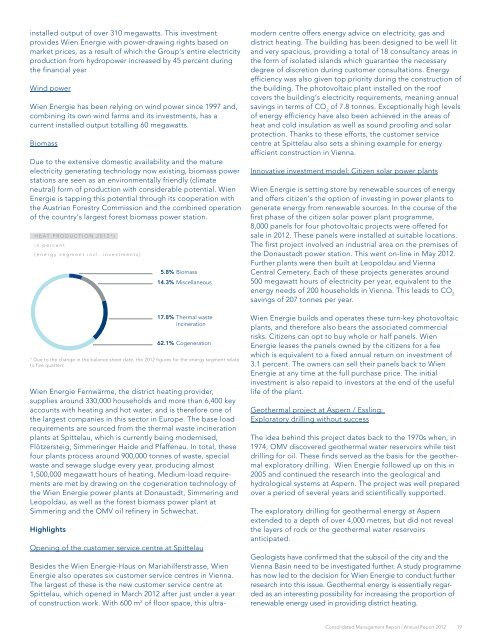Wiener Stadtwerke Annual Report 2012
Create successful ePaper yourself
Turn your PDF publications into a flip-book with our unique Google optimized e-Paper software.
installed output of over 310 megawatts. This investment<br />
provides Wien Energie with power-drawing rights based on<br />
market prices, as a result of which the Group‘s entire electricity<br />
production from hydropower increased by 45 percent during<br />
the financial year<br />
Wind power<br />
Wien Energie has been relying on wind power since 1997 and,<br />
combining its own wind farms and its investments, has a<br />
current installed output totalling 60 megawatts.<br />
Biomass<br />
Due to the extensive domestic availability and the mature<br />
electricity generating technology now existing, biomass power<br />
stations are seen as an environmentally friendly (climate<br />
neutral) form of production with considerable potential. Wien<br />
Energie is tapping this potential through its cooperation with<br />
the Austrian Forestry Commission and the combined operation<br />
of the country‘s largest forest biomass power station.<br />
HEAT PRODUCTION <strong>2012</strong>*)<br />
in percent<br />
(energy segment incl. investments)<br />
5.8% Biomass<br />
14.3% Miscellaneous<br />
17.8% Thermal waste<br />
incineration<br />
62.1% Cogeneration<br />
*) Due to the change in the balance sheet date, the <strong>2012</strong> figures for the energy segment relate<br />
to five quarters<br />
Wien Energie Fernwärme, the district heating provider,<br />
supplies around 330,000 households and more than 6,400 key<br />
accounts with heating and hot water, and is therefore one of<br />
the largest companies in this sector in Europe. The base load<br />
requirements are sourced from the thermal waste incineration<br />
plants at Spittelau, which is currently being modernised,<br />
Flötzersteig, Simmeringer Haide and Pfaffenau. In total, these<br />
four plants process around 900,000 tonnes of waste, special<br />
waste and sewage sludge every year, producing almost<br />
1,500,000 megawatt hours of heating. Medium-load requirements<br />
are met by drawing on the cogeneration technology of<br />
the Wien Energie power plants at Donaustadt, Simmering and<br />
Leopoldau, as well as the forest biomass power plant at<br />
Simmering and the OMV oil refinery in Schwechat.<br />
highlights<br />
Opening of the customer service centre at Spittelau<br />
Besides the Wien Energie-Haus on Mariahilferstrasse, Wien<br />
Energie also operates six customer service centres in Vienna.<br />
The largest of these is the new customer service centre at<br />
Spittelau, which opened in March <strong>2012</strong> after just under a year<br />
of construction work. With 600 m 2 of floor space, this ultra-<br />
modern centre offers energy advice on electricity, gas and<br />
district heating. The building has been designed to be well lit<br />
and very spacious, providing a total of 18 consultancy areas in<br />
the form of isolated islands which guarantee the necessary<br />
degree of discretion during customer consultations. Energy<br />
efficiency was also given top priority during the construction of<br />
the building. The photovoltaic plant installed on the roof<br />
covers the building‘s electricity requirements, meaning annual<br />
savings in terms of CO 2 of 7.8 tonnes. Exceptionally high levels<br />
of energy efficiency have also been achieved in the areas of<br />
heat and cold insulation as well as sound proofing and solar<br />
protection. Thanks to these efforts, the customer service<br />
centre at Spittelau also sets a shining example for energy<br />
efficient construction in Vienna.<br />
Innovative investment model: Citizen solar power plants<br />
Wien Energie is setting store by renewable sources of energy<br />
and offers citizen‘s the option of investing in power plants to<br />
generate energy from renewable sources. In the course of the<br />
first phase of the citizen solar power plant programme,<br />
8,000 panels for four photovoltaic projects were offered for<br />
sale in <strong>2012</strong>. These panels were installed at suitable locations.<br />
The first project involved an industrial area on the premises of<br />
the Donaustadt power station. This went on-line in May <strong>2012</strong>.<br />
Further plants were then built at Leopoldau and Vienna<br />
Central Cemetery. Each of these projects generates around<br />
500 megawatt hours of electricity per year, equivalent to the<br />
energy needs of 200 households in Vienna. This leads to CO 2<br />
savings of 207 tonnes per year.<br />
Wien Energie builds and operates these turn-key photovoltaic<br />
plants, and therefore also bears the associated commercial<br />
risks. Citizens can opt to buy whole or half panels. Wien<br />
Energie leases the panels owned by the citizens for a fee<br />
which is equivalent to a fixed annual return on investment of<br />
3.1 percent. The owners can sell their panels back to Wien<br />
Energie at any time at the full purchase price. The initial<br />
investment is also repaid to investors at the end of the useful<br />
life of the plant.<br />
Geothermal project at Aspern / Essling:<br />
Exploratory drilling without success<br />
The idea behind this project dates back to the 1970s when, in<br />
1974, OMV discovered geothermal water reservoirs while test<br />
drilling for oil. These finds served as the basis for the geothermal<br />
exploratory drilling. Wien Energie followed up on this in<br />
2005 and continued the research into the geological and<br />
hydrological systems at Aspern. The project was well prepared<br />
over a period of several years and scientifically supported.<br />
The exploratory drilling for geothermal energy at Aspern<br />
extended to a depth of over 4,000 metres, but did not reveal<br />
the layers of rock or the geothermal water reservoirs<br />
anticipated.<br />
Geologists have confirmed that the subsoil of the city and the<br />
Vienna Basin need to be investigated further. A study programme<br />
has now led to the decision for Wien Energie to conduct further<br />
research into this issue. Geothermal energy is essentially regarded<br />
as an interesting possibility for increasing the proportion of<br />
renewable energy used in providing district heating.<br />
Consolidated Management <strong>Report</strong> | <strong>Annual</strong> <strong>Report</strong> <strong>2012</strong><br />
19




